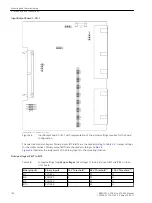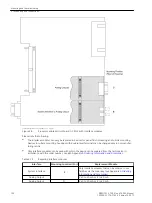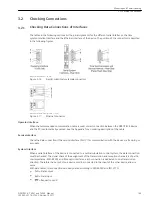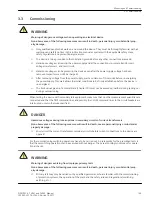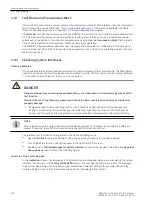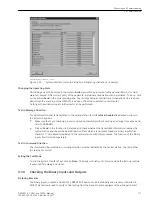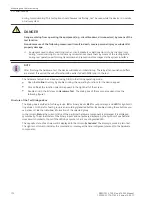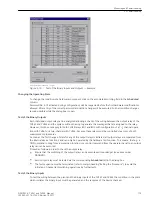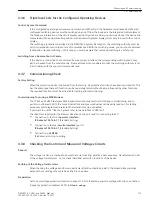
Time Synchronization Interface
Either DC 5 V, 12 V or 24 V time synchronization signals can be processed if the connections are made as indi-
cated in the table below.
Table 3-18
D-subminiature connector assignment of the time synchronization interface
Pin-No.
Description
Signal Meaning
1
P24_TSIG
Input 24 V
2
P5_TSIG
Input 5 V
3
M_TSIG
Return Line
4
–
1)
–
1)
5
SHIELD
Shield Potential
6
–
–
7
P12_TSIG
Input 12 V
8
P_TSYNC
1)
Input 24 V
1)
9
SHIELD
Shield Potential
1)
assigned, but not used
Fibre-optic Cables
!
WARNING
Laser rays!
²
Do not look directly into the fiber-optic elements!
Signals transmitted via optical fibers are unaffected by interference. The fibers guarantee electrical isolation
between the connections. Transmit and receive connections are represented by symbols.
The character idle state for the optical fibre interface is “Light off”. If the character idle state is to be changed,
use the operating program DIGSI, as described in the SIPROTEC 4 System Description.
Checking the Device Connections
General
By checking the device connections the correct installation of the protection device e.g. in the cubicle must be
tested and ensured. This includes wiring check and functionality as per drawings, visual assessment of the
protection system, and a simplified functional check of the protection device.
Auxiliary Power Supply
Before the device is connected for the first time to voltage, it should be have been at least 2 hours in its oper-
ating room, in order to attain temperature equilibrium and to avoid dampness and condensation.
i
i
NOTE
If a redundant supply is used, there must be a permanent, i.e. uninterruptible connection between the
minus polarity connectors of system 1 and system 2 of the DC voltage supply (no switching device, no
fuse), because otherwise there is a risk of voltage doubling in case of a double earth fault.
Switch on the auxiliary voltage circuit breaker (supply protection), check voltage polarity and amplitude at the
device terminals or at the connection modules.
3.2.2
Mounting and Commissioning
3.2 Checking Connections
SIPROTEC 4, 7VE61 and 7VE63, Manual
165
C53000-G1176-C163-3, Edition 10.2017
Summary of Contents for SIPROTEC 4 7VE61
Page 8: ...8 SIPROTEC 4 7VE61 and 7VE63 Manual C53000 G1176 C163 3 Edition 10 2017 ...
Page 24: ...24 SIPROTEC 4 7VE61 and 7VE63 Manual C53000 G1176 C163 3 Edition 10 2017 ...
Page 142: ...142 SIPROTEC 4 7VE61 and 7VE63 Manual C53000 G1176 C163 3 Edition 10 2017 ...
Page 192: ...192 SIPROTEC 4 7VE61 and 7VE63 Manual C53000 G1176 C163 3 Edition 10 2017 ...
Page 222: ...222 SIPROTEC 4 7VE61 and 7VE63 Manual C53000 G1176 C163 3 Edition 10 2017 ...
Page 230: ...230 SIPROTEC 4 7VE61 and 7VE63 Manual C53000 G1176 C163 3 Edition 10 2017 ...
Page 256: ...256 SIPROTEC 4 7VE61 and 7VE63 Manual C53000 G1176 C163 3 Edition 10 2017 ...
Page 314: ...314 SIPROTEC 4 7VE61 and 7VE63 Manual C53000 G1176 C163 3 Edition 10 2017 ...
Page 316: ...316 SIPROTEC 4 7VE61 and 7VE63 Manual C53000 G1176 C163 3 Edition 10 2017 ...
Page 330: ...330 SIPROTEC 4 7VE61 and 7VE63 Manual C53000 G1176 C163 3 Edition 10 2017 ...


